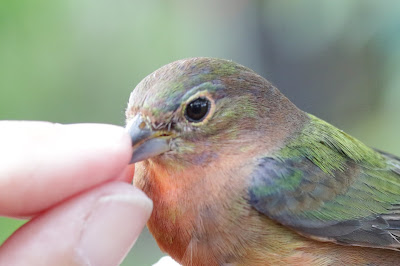On Saturday we returned to PB 5. We had brought this host a caged feeder much like the one on the Encouraging Painted Buntings Page on this blog. It fits our traps so we were anxious to see how things were going. We banded 3 new Painted Buntings and likely would have caught more but the Northern Cardinals thought it was their turn We banded 6 cardinals and recaptured one. We also banded 3 Indigo Buntings, a Common Ground-Dove, 2 Blue Jays and 2 Mourning Doves.
After a little while we also set up a net away from the caged feeder. Good thing we did!! We caught a Painted Bunting that we had not banded. We reported this bird to the Bird Banding Laboratory where all banding data is stored/processed/analyzed. The initial report was that the bird was banded in South Carolina in fall of 2015 as a young bird. It is still green and we observed feathers that told us that it was an adult bird - a female. "Foreign" recaptures like this are very rare. The bird did not have any color bands and is likely NOT one of the ones from the breeding research being done in North Carolina. We are anxiously waiting more information from the bander.
Indigo Bunting (SY) as told by the small dark feathers over the thumb
Indigo Bunting (ASY) as told by the blue edged small feathers over the thumb
Photos by Bill LaFramboise
Northern Cardinal - female with brood patch
The Indigo Buntings were a great illustration of aging this species. The first photo is a SY (second year) bird born last summer. The second is an ASY (After Second Year) adult. Both are males.
The cardinal is showing a brood patch and is likely nesting or possibly feeding nestlings. The belly feathers are gone, the skin is swollen but likely diminishing as it has a wrinkled instead of a blistered appearance. The brood patch forms to warm the eggs in the nest.
Painted Buntings
Photos by Bill LaFramboise
On Tuesday we banded our scheduled session at Possum Long. It was quite windy and the birds were either absent or really hunkered down. We recaptured a Northern Cardinal and a Painted Bunting. We also banded one new Gray Catbird. We stayed long enough to talk with a visiting school group and then we closed up. Year-round residents were there, a few Great Crested Flycatchers were back for the nesting season, and the only warbler seen was 1 Prairie Warbler.
Next Possum Long banding will be April 3, 2018. Nets go up at 6:45.










































